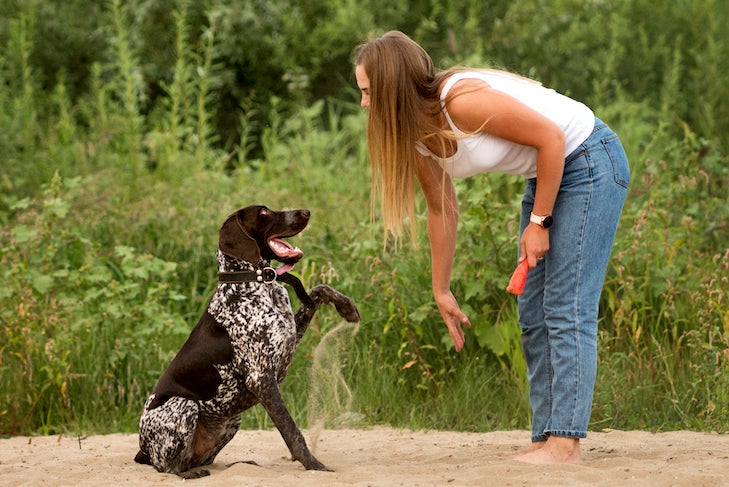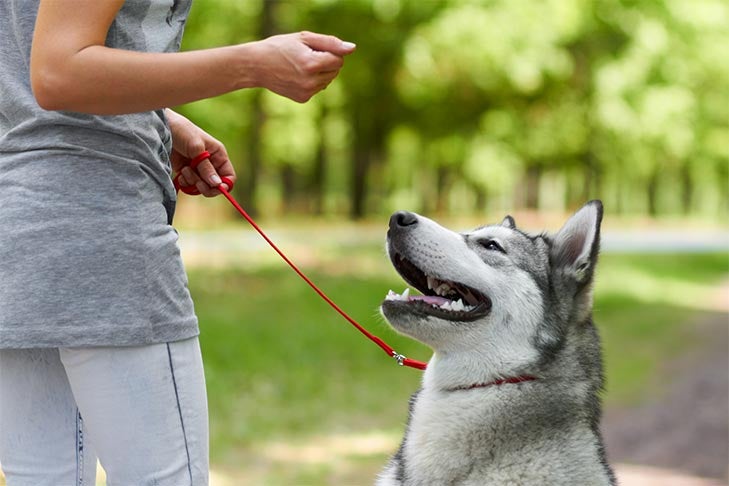
AKC is a participant in affiliate advertising programs designed to provide a means for sites to earn advertising fees by advertising and linking to akc.org. If you purchase a product through this article, we may receive a portion of the sale.
Lure-and-reward training is a simple and relatively quick way to teach your dog new behaviors. It works if you’re teaching your dog positions like lying down or movements such as heeling (walking beside you). Although this method is useful at first, people often struggle to wean their dog off the lure and onto a hand signal or verbal cue alone. If you’ve ever felt like your dog will only listen when you have a treat in your hand, you may have missed a crucial step in the process. Here’s how to make lure-and-reward training an effective training strategy.
Lure-and-Reward Training: Understanding Basics
The lure-and-reward method uses a dog treat to lure your dog into different behaviors. Simply hold a delicious and motivating treat (the lure) to your dog’s nose, then slowly move it around to get them to move the way you want. The treat acts like a magnet for your dog’s nose. So wherever their head goes, their body will follow.
For example, if you want your dog to sit, move the treat up and slightly over their head. As they look up at the treat, their rear will fall to the ground. If you want your dog to spin around, move the treat in a circle above their head. After your dog completes the behavior, reward them so that they know they did what you wanted.
For your dog to get the right idea, you’ll probably only need to do a few repetitions with food in your hand. Once your dog is reliably following the lure, it’s time to fade the lure. This way, your dog won’t become reliant on seeing the treat to perform the behavior.
Continue to repeat the hand motion, but without any food. Your dog should follow your empty hand the same way they followed the treat. Reward them with another dog treat after they do what you directed.

The motion of your empty hand will naturally become a hand signal for your dog. Repetition by repetition, you can gradually make your hand motion smaller and subtler. For example, rather than starting at your dog’s nose and moving with them, you will be able to make the gesture at your side.
Once your dog has mastered the behavior, and it looks the way you want with the hand signal alone, you can add the verbal cue. Simply say the verbal cue aloud and wait a moment, then give the hand signal. Be sure to reward your dog when they do what you’ve asked. In time, your dog will learn the word, and you can use just that verbal cue.
How to Fade the Lure
It’s important to fade the lure (move to an empty hand) as quickly as possible. This way, your dog won’t rely on seeing food to perform the behavior you’ve asked them for. Some dogs will follow an empty hand with no problem.
Other dogs may struggle to make the transition. They think they will only get a treat if they can see it from the start. Your dog needs to understand that the lure and the reward are two separate things. To help your dog understand this, here’s how to fade the lure in three steps:
- Lure your dog with a treat. When they do what you’ve asked, give them the lure as a reward.
- Lure your dog with a treat. When they do what you’ve asked, reward them with a treat from your other hand.
- Lure your dog with an empty hand. When they do what you’ve asked, reward them with a treat from your other hand.
If your dog is still struggling to make the switch from a dog food lure to an empty hand, try rubbing the fingers of your lure hand with a stinky dog treat. As a result, the fingers of your lure hand will smell like that treat, and your dog will think your lure hand is actually holding a tasty snack.
As soon as your dog does perform the behavior, deliver a treat from your other hand. You might also want to keep your treats in a treat pouch until it’s time to reward your dog. This way, your dog will never know where the food is coming from.

You can also try using lures that aren’t food, like a rubber ball or another dog toy. As long as your dog wants to work for it, the item will make a great lure. When you reward your dog, don’t give them the toy every time. Surprise them with something else instead. This will help the dog distinguish between the lure and the reward. It will also prevent them from needing to see what they’ll be getting before listening to you.
If you’re using a dog training clicker or other marker when training your dog, you don’t need to fade it. Instead, you can stop using it outright when your dog no longer needs it. The clicker is a learning tool, so once your dog has mastered performing a behavior with a hand signal or verbal cue, you don’t need to mark the correct behavior anymore. If your dog’s response starts to get sloppy in the future, bring the marker back to help you refine their performance.

